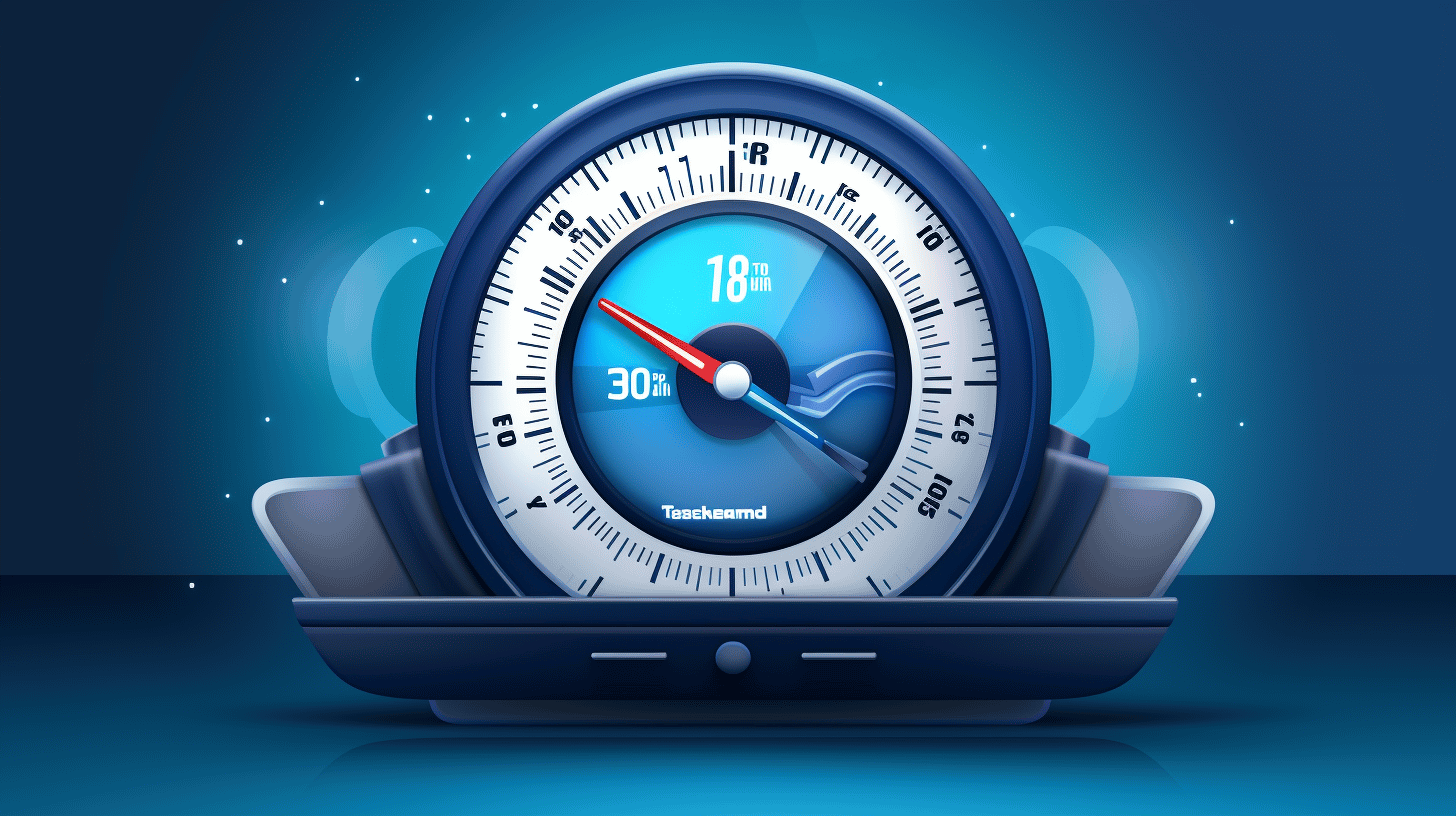在當今快節奏的數位世界中,網站速度對於任何線上業務的成功都起著至關重要的作用。加載緩慢的網站不僅會讓用戶感到沮喪,還會對搜尋引擎排名產生負面影響。這就是 WordPress 速度優化發揮作用的地方。
WordPress 是世界上最受歡迎的內容管理系統 (CMS),為全球數百萬個網站提供支援。雖然 WordPress 網站的靈活性和用戶友好性是首屈一指的,但有時它也會受到效能問題的困擾。幸運的是,有行之有效的策略和技術可以釋放 WordPress 的隱藏潛力並優化其速度。
了解 WordPress 速度優化的重要性
網站速度是直接影響使用者體驗和轉換率的關鍵因素。這就是為什麼 WordPress 速度優化至關重要:
- 使用者體驗: 加載緩慢的網站會導致更高的跳出率,因為用戶往往會放棄加載時間過長的網站。透過優化您的 WordPress 網站的速度,您可以為訪客提供無縫且愉快的瀏覽體驗。
- 搜尋引擎排名: 谷歌等搜尋引擎將網站速度視為排名因素之一。載入速度更快的網站更有可能在搜尋引擎結果頁面(SERP)中排名更高,從而增加自然流量和知名度。
- 行動裝置友善度: 在行動優先時代,擁有一個快速載入的網站變得更加重要。由於網路流量有很大一部分來自行動設備,因此優化 WordPress 網站的速度可確保行動用戶獲得流暢的體驗。
- 轉換率: 研究表明,網站速度越快,轉換率就越高。當您的網站載入速度很快時,訪客更有可能停留更長時間、參與您的內容並轉換為付費客戶或訂閱者。
現在我們了解了 WordPress 速度優化的重要性,讓我們深入了解基本策略,以幫助您釋放 WordPress 網站的隱藏潛力。
⚡️ 對於網站優化來說,速度至關重要。載入緩慢的網站會讓訪客失去興趣並對使用者體驗產生負面影響。此外,Google等搜尋引擎將網站速度視為排名因素。因此,實施速度優化的基本策略以確保您的網站發揮最佳效能至關重要。讓我們深入探討對您網站速度有重大影響的三個關鍵領域。
網站託管的效果💻
選擇正確的託管服務提供者是優化網站速度的基礎步驟之一。您的託管服務的品質會直接影響您網站的載入時間。在評估託管服務提供者時,需要考慮以下幾個關鍵點:
- 伺服器回應時間:尋找提供快速、可靠的伺服器回應時間的託管服務提供者。這可確保當使用者要求您的網站時,伺服器能夠快速回應,從而提供更快的載入體驗。
- 資源分配:確保您的託管計劃為您的網站需求提供足夠的資源。 CPU 或 RAM 不足會降低網站的效能,尤其是在流量高峰期。
- 伺服器位置:考慮託管伺服器相對於目標受眾的位置。如果您的目標用戶主要位於特定區域,選擇靠近該地區的伺服器可以幫助減少延遲並提高載入速度。
主題和外掛優化的重要性🎨🔌
您的網站的主題和您使用的外掛程式會對其載入速度產生重大影響。優化這些元素將有助於更快、更流暢的使用者體驗。以下是一些提示:
- 選擇輕量級主題:選擇輕量級且速度優化的主題。避免使用功能過多和程式碼臃腫的主題,因為它們會降低您的網站速度。
- 禁用未使用的插件:花點時間檢查您安裝的插件並停用或卸載任何不必要的插件。未使用的插件仍然會產生額外的載入時間並可能引入安全漏洞。
- 優化插件設定:配置活動插件的設定以盡量減少它們對您網站效能的影響。檢查選項以啟用快取、延遲載入和其他速度優化功能。
影像優化的價值🖼️
圖像在吸引網站訪客方面發揮著至關重要的作用,但它們也可能是導致頁面載入時間緩慢的主要原因。優化您的圖像可以顯著提高您的網站速度。您可以按照以下方式操作:
- 影像壓縮:使用影像壓縮技術來減小影像的檔案大小而不影響品質。有各種線上工具和外掛程式可以幫助您實現這一點。
- 優化影像格式:根據內容和上下文選擇適當的圖像格式。對於照片和複雜圖像,請使用 JPEG 格式,而 PNG 格式更適合具有透明度的標誌和圖形。
- 延遲載入:實現延遲載入技術,僅當影像位於使用者視窗中時才載入影像。這減少了初始頁面的載入時間,尤其是對於包含多個圖像的長滾動頁面。
請記住,這些基本策略只是個開始。您還可以探索許多其他策略來進一步增強網站的速度優化。透過優先考慮網站託管、主題和外掛優化以及圖像優化,您將能夠提供快速且高效的用戶體驗。
⚡️介紹:
說到網站速度優化,有幾種先進的技術可以顯著提高網站的效能。從縮小 HTML、CSS 和 Javascript 到優化資料庫和實現延遲加載,這些技術可以幫助減少頁面加載時間、改善用戶體驗並提高您的 SEO 排名。讓我們深入研究這些先進的技術並學習如何增強您的網站速度。
1. 壓縮 HTML、CSS 和 Javascript
縮小 HTML、CSS 和 Javascript 檔案涉及刪除不必要的字符,例如註釋、空格和換行符。這種技術減少了整體文件大小,從而可以更快地將其傳送到用戶的瀏覽器。這就是為什麼縮小體積如此重要:
- 更快的載入時間: 縮小程式碼可減少檔案大小,使瀏覽器能夠更快地下載和呈現您的網站,從而縮短載入時間。
- 頻寬優化: 文件越小意味著傳輸的資料傳輸越少,從而為您和您的用戶節省頻寬。
- 瀏覽器快取: 縮小的文件更有可能被瀏覽器緩存,從而使回訪者能夠更快地加載您的網站。
為了縮小程式碼,您可以使用各種工具和插件。以下是一些受歡迎的選擇:
- HTML: HTMLMinifier
- 樣式表: 陣容 或者 自動前綴修復器
- JavaScript的: UglifyJS 或者 特瑟
請記住,在縮小尺寸之前務必備份原始文件,以防出現任何問題。
2.資料庫優化
優化網站的資料庫對於提高速度和整體效能至關重要。優化良好的資料庫可確保高效查詢並減少檢索和儲存資料所需的時間。以下是優化資料庫的一些基本技巧:
- 定期清理: 刪除不必要的數據,例如未使用的外掛程式、主題或過時的內容。這有助於減少資料庫的大小並提高查詢效能。
- 索引: 索引就像在書中建立索引一樣——它可以幫助資料庫更快地定位和檢索資料。找出經常查詢的列,並新增索引以加快搜尋查詢。
- 資料庫緩存: 實現資料庫快取機制,將經常存取的資料儲存在記憶體中,減少重複資料庫查詢的需要。
- 資料庫壓縮: 壓縮資料庫可以進一步減少其大小,從而加快備份和恢復速度並提高整體效能。
不同的內容管理系統(CMS)有自己的最佳化插件和工具。請務必探索特定於您的 CMS 的選項,例如 WordPress 插件 WP-最佳化 或者 WP火箭.
3. 延遲加載
延遲加載是一種有效的技術,它可以延遲某些資源(例如圖像或視訊)的加載,直到需要它們為止。透過實現延遲加載,您可以僅先加載必要的內容,從而顯著改善網站的初始加載時間。讓我們看看實現延遲載入的一些好處和方法:
- 減少初始載入時間: 透過延遲非必要資源的加載,您的網站可以更快地向用戶顯示可見內容,從而給人留下更好的第一印象。
- 提高頁面速度: 透過僅在圖像、視訊或 iframe 進入視口時進行加載,延遲加載減少了請求和傳輸的資料數量,從而提高了整體頁面速度。
- 插件整合: 許多 CMS 平台都提供插件,使得實作延遲載入變得像安裝和啟用一樣簡單。例如, 延遲載入 WordPress 外掛程式是一個受歡迎的選擇。
請記住在實施延遲加載後徹底測試您的網站,以確保所有內容都正確加載並且用戶體驗保持無縫。
⚡️結論:
實施先進的速度優化技術可以大大提高您網站的效能,從而縮短載入時間、改善用戶體驗並提高 SEO 排名。透過縮小 HTML、CSS 和 Javascript、優化資料庫和實現延遲加載,您可以增強網站功能並為訪客提供更快、更無縫的瀏覽體驗。立即開始實施這些技術,並觀察您的網站速度飆升!
瀏覽器快取的定義和優點
瀏覽網路時,您是否注意到某些網站的載入速度比其他網站更快?這種速度差異背後的原因之一是瀏覽器快取。
🤔 但是瀏覽器快取到底是什麼?
簡單來說,瀏覽器快取是一個允許網頁瀏覽器將網站的某些資源(例如圖像、JavaScript 檔案和 CSS 檔案)儲存在本機裝置上的過程。透過將這些資源儲存在本地,您的瀏覽器可以快速存取它們,而無需在每次造訪網站時下載它們。
💡 那麼瀏覽器快取為什麼是有益的呢?
那麼,利用瀏覽器快取有以下幾個優點:
- 更快的網站載入時間: 透過在本地儲存資源,後續造訪相同網站的速度會顯著加快,因為瀏覽器不必再次取得所有資源。
- 減少伺服器負載: 當瀏覽器載入網頁時,它會向伺服器發送多個請求以獲取所有所需的資源。透過快取這些資源,可以減少對伺服器的請求數量,從而減輕伺服器負載並提高網站效能。
- 節省頻寬: 快取資源利用使用者的本機存儲,減少重複下載相同檔案的需求。這可以節省大量頻寬,特別是對於內容繁多或流量大的網站。
在 WordPress 上實作快取的方法
現在我們了解了瀏覽器快取的好處,讓我們探索在 WordPress 等流行平台上實現它的一些方法。 WordPress 提供了幾個插件,使快取實現變得輕而易舉。以下是一些流行的選擇:
- W3 總緩存: 該插件因其全面的快取功能而受到廣泛認可。它提供頁面快取、物件快取、資料庫快取和瀏覽器快取等功能。 W3 Total Cache 可以顯著提高您的網站速度和效能。
- WP超級快取: 另一個流行的快取外掛程式 WP Super Cache 從您的動態 WordPress 網站產生靜態 HTML 檔案。這些靜態檔案可以提供給用戶,從而加快載入時間並減少伺服器負載。
- WP火箭: WP Rocket 被認為是 WordPress 最好的快取外掛之一,它提供了易於使用的介面和一系列優化功能。它會自動啟用瀏覽器快取、頁面快取和 GZIP 壓縮,無需大量手動配置即可提供更快的網站。
請記住,在您的 WordPress 網站上實施快取不僅可以改善用戶體驗,還可以透過提高網站的速度和效能對您的 SEO 工作產生積極影響。
了解伺服器端優化及其好處
除了瀏覽器快取之外,伺服器端優化對於提高網站效能也起著至關重要的作用。伺服器端優化是指在伺服器端(託管環境)進行特定調整以提高網站速度和效率。以下是伺服器端優化的一些好處:
- 減少伺服器回應時間: 透過優化伺服器設定(例如伺服器配置、快取機制和負載平衡),您可以顯著減少伺服器回應瀏覽器請求所需的時間。
- 增強的可擴展性: 有效的伺服器端優化可確保您的網站可以處理大量流量而不會減慢速度或崩潰。這在高峰時段或進行高流量活動時尤其重要。
- 提高安全性: 伺服器端優化可以包括實施強大的防火牆、定期更新伺服器軟體和監控潛在漏洞等措施。這些安全增強功能有助於保護您的網站和使用者的敏感資料免受潛在威脅。
投資伺服器端優化是一種積極主動的方法,可確保您的網站快速、有效率且安全。透過優化伺服器設置,您可以為訪客提供無縫的瀏覽體驗,同時保護他們免受潛在的安全風險。
因此,無論您選擇利用瀏覽器快取還是優化伺服器端設置,這兩種策略都有助於提高網站效能、加快載入時間並全面增強用戶體驗。不要猶豫,實施這些優化技術,讓您的網站更具競爭優勢!
在當今數位時代,網站速度對於使用者體驗和整體線上成功起著至關重要的作用。網站載入緩慢會讓訪客感到沮喪,導致跳出率高、參與度降低,甚至可能造成收入損失。這就是內容傳遞網路 (CDN) 發揮作用的地方。 CDN 是優化網站速度和效能的強大工具,可確保您的內容快速有效地傳遞給全球用戶。
什麼是 CDN?
內容傳遞網路 (CDN) 是位於多個地理位置策略位置的伺服器網路。 CDN 不是從單一伺服器提供內容,而是從最靠近請求該內容的使用者的伺服器提供您的網站內容。這種分散式網路不僅可以減少延遲,而且還有助於有效處理繁重的流量負載。
可以將 CDN 視為一支分佈在不同地區的龐大的運輸車隊。當紐約的用戶要求您的網站時,CDN 不會從您位於加州的伺服器取得內容,而是從紐約附近的邊緣伺服器提供內容。這減少了資料傳輸的距離,從而縮短了載入時間。
CDN 如何提升網站速度?
CDN 的主要功能是透過減少延遲和改善內容傳遞來優化網站速度。 CDN 如何利用其伺服器網路來提升網站效能:
- 快取:CDN 在其邊緣伺服器上儲存靜態網站內容,例如圖像、CSS 檔案和 JavaScript。當使用者請求您的網站時,CDN 會提供快取的內容,而不是從您的伺服器取得。這大大減少了原始伺服器的負載,從而加快了頁面載入時間。
- 地理分佈:透過在世界各地策略性地放置邊緣伺服器,CDN 可以最大限度地縮短使用者和內容之間的實體距離。這種接近性確保了無論用戶身在何處都能迅速將內容傳遞給用戶,從而改善整體用戶體驗。
- 負載平衡:CDN 透過在多台伺服器之間分配流量來優化網站效能。當您的網站流量激增時,CDN 會自動在其伺服器之間平衡負載,防止任何單一伺服器不堪重負並導致回應時間變慢。
- 分散式阻斷服務 (DDoS) 保護:許多 CDN 都提供內建的 DDoS 保護,保護您的網站免受可能削弱伺服器效能的惡意攻擊。透過過濾流量並將其分佈到多個伺服器,CDN 有助於確保您的網站即使在遭受此類攻擊時也能保持可用性和速度。
為 WordPress 選擇正確的 CDN
如果您使用 WordPress 來支援您的網站,則有幾種專為該平台設計的 CDN 選項可供選擇。以下是為您的 WordPress 網站選擇合適的 CDN 時需要考慮的一些因素:
- 一體化:尋找與 WordPress 無縫整合的 CDN。這確保您可以輕鬆設定和管理內容傳遞網絡,而無需任何技術專長。
- 表現:考慮 CDN 的網路覆蓋範圍及其邊緣伺服器的速度。透過分析其快取功能、負載平衡效率和整體傳輸速度來評估它對您特定網站的效能優化程度。
- 可靠性:選擇提供高正常運作時間的 CDN,以確保使用者始終可以造訪您的網站。尋找確保可靠性並最大限度減少停機時間的保證和 SLA(服務等級協定)。
- 支授:確保當您遇到任何問題或需要配置協助時,CDN 提供者能夠提供專門的支援和協助。
有了正確的 CDN,您可以顯著提高網站的速度和使用者體驗。因此,請花時間評估可用選項並選擇符合您的特定需求和目標的 CDN。
在實施了 WordPress 速度優化的基本和進階策略後,仍有一些專家提示和最終想法需要考慮。這些技巧將幫助您保持網站速度並確保它繼續提供出色的用戶體驗。
🚀 長期保持速度優化
速度優化不是一次性的任務。它需要持續的監控和維護以確保您的網站保持快速且反應迅速。以下是一些專家提示,可幫助您長期維持網站速度:
- 定期監控網站效能:使用 Google PageSpeed Insights 或 GTmetrix 等工具關注網站的速度。定期性能檢查將幫助您發現任何潛在問題並及時採取措施解決它們。
- 優化內容更新:每當您新增內容或對網站進行變更時,請確保優化其速度。這包括優化圖像、縮小和合併 CSS 和 JavaScript 檔案以及使用快取技術。
- 刪除未使用的外掛程式和主題:定期檢查您安裝的外掛程式和主題。刪除任何不必要的或未使用的,以減輕網站資源的負擔並縮短載入時間。
- 實施內容傳遞網路 (CDN):如果您還沒有,請考慮使用 CDN 來進一步提高您網站的速度。 CDN 在全球多個伺服器上快取您的網站內容,從而縮短您的網站與其使用者之間的距離並縮短載入時間。
💡 定期更新和速度檢查至關重要
WordPress 及其外掛程式不斷發展,並定期發布更新以提高效能和安全性。確保定期更新您的 WordPress 核心、主題和插件,以享受最新的速度優化和錯誤修復。
此外,定期進行速度檢查以確保您的網站效能不受影響至關重要。當您新增功能或對網站進行變更時,這些檢查可協助您識別任何潛在的速度減慢並及時解決。
🔚 結論
優化您的 WordPress 網站速度對於提供積極的用戶體驗和提高您的搜尋引擎排名至關重要。透過遵循本文討論的基本和進階速度優化技術,您可以顯著提高網站的效能。
請記住,優化網站速度是一個持續的過程。定期監控您的網站,保持最佳實踐,並結合專家提示,以確保您的網站長期保持快速和高效。
透過正確的策略和持續的努力,您可以釋放 WordPress 網站的隱藏潛力,並為訪客提供閃電般的瀏覽體驗。那麼,您還在等什麼呢?立即開始優化您的網站速度並享受其帶來的好處!
常見問題解答
- 為什麼網站速度優化對 WordPress 很重要?
網站速度優化對於 WordPress 來說非常重要,因為快速載入的網站可以改善使用者體驗、降低跳出率、提高 SEO 排名、增加轉換率並提升整體網站效能。
- 有哪些行之有效的 WordPress 速度優化策略?
一些經過驗證的 WordPress 速度優化策略包括最小化 HTTP 請求、優化圖像、使用快取插件、啟用 GZIP 壓縮、最小化 CSS 和 JavaScript 檔案、選擇可靠的託管服務提供者以及使用內容分發網路 (CDN)。
- 快取外掛如何幫助優化 WordPress 速度?
快取外掛程式會建立動態 WordPress 頁面的靜態版本,從而減少伺服器負載並縮短頁面載入時間。它們將快取檔案儲存在使用者的瀏覽器上,使得後續的頁面存取更快、更有效率。
- 網站速度對SEO有什麼影響?
網站速度是 SEO 的關鍵因素。搜尋引擎優先考慮快速加載的網站並將其視為排名因素。網站速度緩慢可能會對您的搜尋引擎排名和自然流量產生負面影響。
- 是否有專門為速度優化而設計的可靠的 WordPress 外掛?
是的,有幾個專門為速度優化而設計的可靠的 WordPress 外掛。一些流行的包括 WP Rocket、W3 Total Cache、WP Super Cache 和 Autoptimize。這些插件提供各種功能和設定來提高網站效能。



















